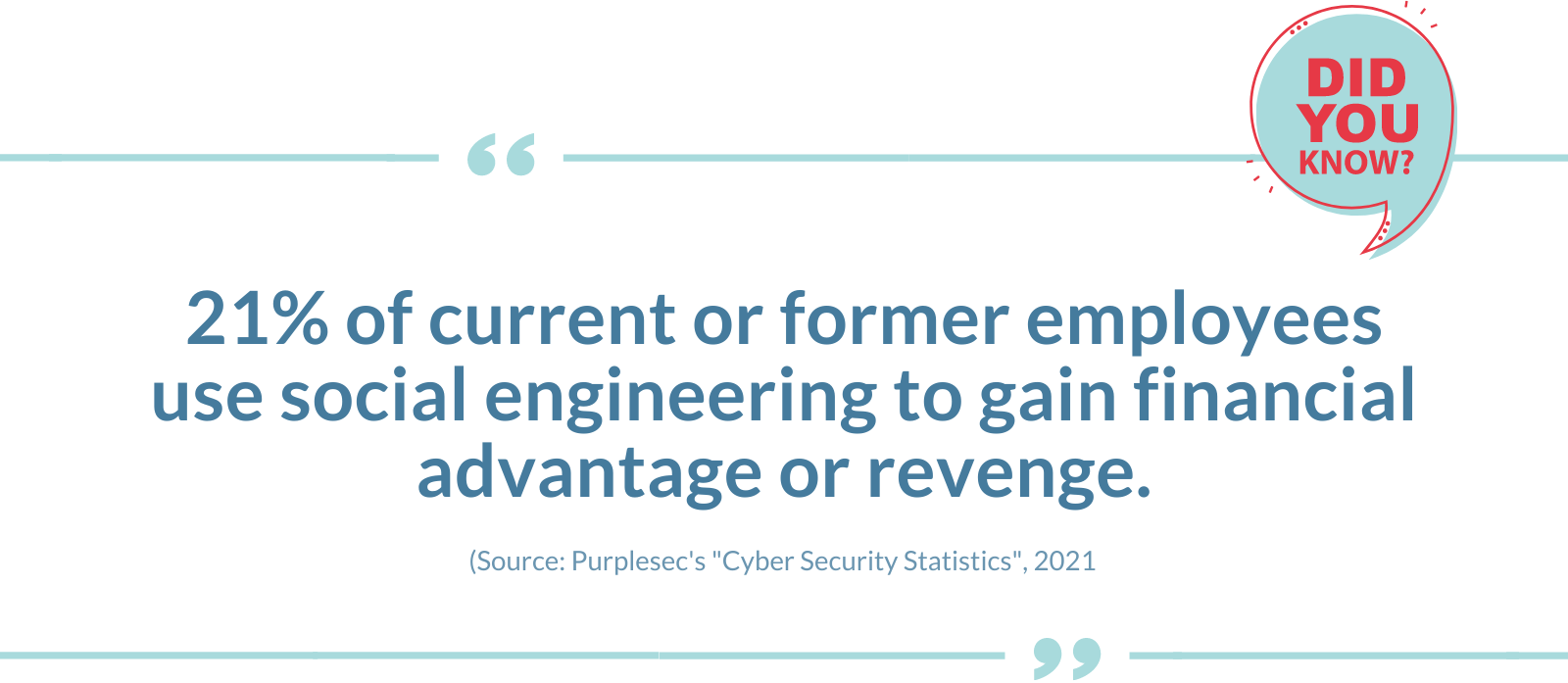A cyber attack on your company could cost you millions of dollars and cause you to lose customers. There’s no surprise that companies are doing everything they can to protect against cyber criminals. With that said, most companies’ cybersecurity strategy focuses on things like firewalls and antivirus solutions. While these apps are essential, they can’t protect you against one of the cybercriminal’s favored methods. Social engineering attacks can bypass your cyber defenses and do massive damage to your company. So what is social engineering, and how can you protect your company against it? Read on to find out more.
What is Social Engineering?
Social engineering is when cyber criminals use sophisticated social trickery to access systems. The trouble with a social engineering attack is that it involves deceiving people rather than computer systems. This means that your cybersecurity software probably won’t be able to prevent social engineering attacks.
If a social engineering attacker tricks one of your employees into giving up their password, your cybersecurity setup simply won’t recognize them as an intruder. Social engineering attacks are, therefore, a significant problem for businesses that rely on IT systems.
Firewalls and antivirus software are becoming more powerful. So criminals are turning to social engineering techniques to commit crimes.
According to some statistics, hackers use social engineering in 98% of their cyber attacks. The following social engineering tactics could cause security problems for your business.
Whaling Attacks
A whaling attack is when cyber criminals target a specific person or group of people with a social engineering attack. For example, the attackers might send an email to a particular person hoping to scam them.
Generally, the victims have access to some kind of computer system that the criminals want to break into. They may attempt to trick the victim into giving up their password. They might also try to convince the victim to transfer money to the attacker’s account.
One of the defining features of a whaling attack is the sense of urgency the hackers convey. The hackers will always try to convince the victim to take action as quickly as possible. The hackers know they stand the best chance of success if they don’t give the victim much time to think.
Successful whaling attacks use carefully crafted language tailored to the targets to make the attack seem as convincing as possible. These attacks often target C-level executives, but cybercriminals will target almost anyone they think has enough authority.
In a whaling attack, the criminals might also try to impersonate C-level executives. For example, in 2016, hackers tricked an employee at Snapchat into giving up payroll information by pretending to be the Snapchat CEO in an email.
How Managed IT Services Can Protect You Against Whaling Attacks
Protecting against whaling attacks using technological solutions can be challenging, but some potential safeguards exist.
Managed IT services could help you set up a permissions system on your network. This means that you can restrict the level of information that certain employees have access to.
You can then only grant workers permission to access the files they need to do their job. While this doesn’t completely mitigate the risk of a whaling attack, it does help minimize the number of people criminals can target.
Your permissions system can help you to identify employees who criminals may target. You can then train these at-risk employees to identify whaling attacks.
Watering Hole Attacks
A watering hole attack is when criminals put malicious code on a site or program they know their targets will use. For example, they might compromise an industry-specific website in the hope of infecting computers on your company network.
This kind of attack can be challenging to recognize. If the attackers execute a watering hole attack well, the victim won’t even notice. An example of a successful watering hole attack was when attackers managed to sneak malicious code into the app Ccleaner.
Thankfully, you can take some basic precautions to protect your company.
How Managed IT Services Can Protect You Against Watering Hole Attacks
One of the main ways that managed IT services can protect your company against watering hole attacks is by ensuring all your apps are up to date. These kinds of attacks often only work because the hackers exploit vulnerabilities in software.
Software developers usually quickly identify these issues and push out a security patch. As long as you constantly update to the latest version, you should be protected. Of course, keeping everything updated on an extensive company network can be difficult, but managed IT services can ensure everything stays updated.
Pretexting Attack
A pretexting attack is when a cybercriminal creates a social situation where the victim gives out personal information. In normal circumstances, the victim would never give up this information, but the hackers create a scenario where the victim feels like they need to.
Criminals using this type of attack try to exploit human psychology. For example, they might present themselves as someone in a leadership position. They may also try to present themselves as someone the victim can trust.
How Managed IT Services Can Protect You Against Pretexting Attacks
The best way to protect against this kind of attack is to make it more difficult to access your systems with just one piece of information. For example, you could use multi-factor authentication.
This is when you need to confirm your login from a second device. Typically, this involves logging in and providing a code you receive on your phone.
This makes it much more difficult for an attacker to use pretexting. With multi-factor security at play, an attacker must gain access to your password and verification code.
A managed IT services company can quickly implement this kind of security system for your company.
Baiting Attacks
A baiting attack is when criminals leave some kind of digital bait for a victim to find. Once the victim takes the bait, the USB stick will execute malicious code on their system. A popular way of making a baiting attack is by leaving a USB stick lying around somewhere a victim will find it.
Most people would be curious about what’s on the device. They might then plug the USB stick into a work computer. At this point, the malicious code executes, and the network is compromised.
For example, in 2022, the hacking group FIN7 sent USB drives laced with malicious software to various organizations.
How Managed IT Services Can Protect You Against Baiting Attacks
There are several ways managed IT services could protect your company from this kind of attack. They could make it impossible for workers to plug in their USB sticks. If you have workers who don’t need to do this to do their job, this solution makes a lot of sense.
If this solution isn’t viable, they can also install robust antivirus software on your computer network. In many cases, good antivirus software detects and refuses to open the malicious code.
Managed IT services will also back up all your essential data. If the antivirus fails, they can simply shut down the network and revert to an old backup. When done correctly, it will be like the baiting attack never happened.
Phishing Attacks
A phishing attack is when cyber criminals set up a fake website. They make this site look authentic, but when the victim inputs their information, it sends it straight to the hackers. A phishing attack might also involve sending fake invoices to a company to try and get victims to pay.
Cybercriminals might target your company by setting up a fake login portal for your company’s website. This could trick your workers into providing their passwords. In some cases, the criminals can even spoof the URL to appear to be a legitimate site.
Even big tech companies like Google and Facebook are targeted. In 2016 a phishing scammer earned $100 million by sending these companies fake invoices.
How Managed IT Services Can Protect You Against Phishing Attacks
Phishing attacks are often made through email. Managed IT services can install a filtering system to block phishing emails. They can also protect your company from malicious websites by setting up a proxy server.
Again, a two-factor password system also helps because attackers need more than one password to access your company.
Protect Your Company Against Social Engineering
As you can see, social engineering attacks pose a massive threat to your company. The good news is that managed IT services can help you implement security solutions to protect you. Working with a good managed IT solutions company and having a solid security culture will help keep your company safe.
If you want to work with an experienced managed IT services company, contact us today.






